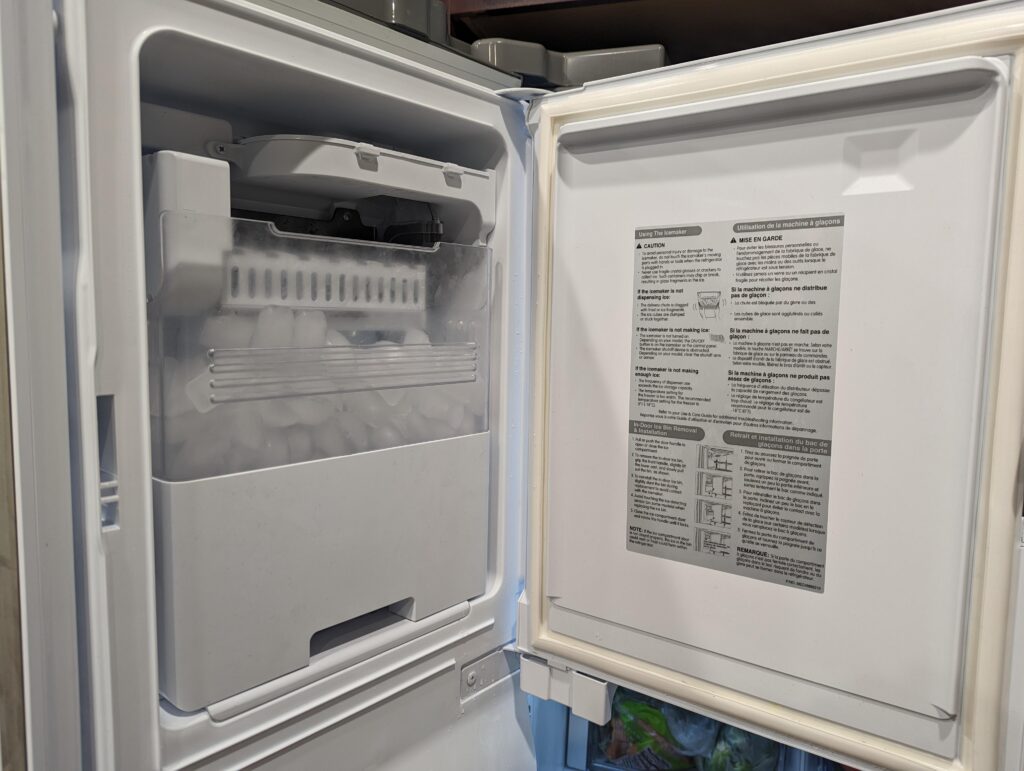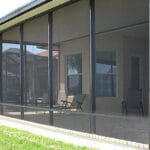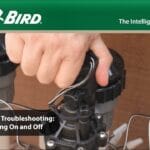To troubleshoot a Kenmore refrigerator ice maker, first check the water supply line for kinks. Ensure the freezer temperature is set between 0°F and 5°F.
Troubleshooting a Kenmore refrigerator ice maker can often feel like a daunting task. Yet, with the right approach, it becomes manageable. Your Kenmore fridge is an essential household appliance, keeping your food fresh and your drinks cold. However, when the ice maker stops functioning correctly, it disrupts your daily routine.
Many issues can be solved with simple checks and adjustments. Identifying common problems like water line disruptions, incorrect freezer settings, or clogged filters paves the way for quick fixes. By focusing on these areas first, you can often restore your ice maker to optimal performance without needing professional help. This guide aims to demystify the process, offering clear and straightforward steps to get your Kenmore refrigerator’s ice maker back in action.
Introduction To Kenmore Ice Maker Issues
Your Kenmore refrigerator is the heart of your kitchen. But when the ice maker fails, it can disrupt your daily life. Understanding common issues with Kenmore ice makers is essential. It helps you keep everything running smoothly.
Common Symptoms Of Malfunction
- No ice production – The ice maker stops making ice.
- Small or hollow cubes – Ice size and quality are poor.
- Leaks or water spills – Water leaks inside or outside the fridge.
- Strange noises – Unusual sounds come from the ice maker.
Importance Of Timely Troubleshooting
Quick action prevents more issues. It saves you time and money. Regular maintenance keeps your Kenmore ice maker in top shape. This ensures a steady supply of ice when you need it.
Initial Checks Before Troubleshooting
Kenmore refrigerator ice makers need care to work well. Small issues can stop ice production. Before you call for help, try simple fixes. Check power and water connections first. This guide helps you start troubleshooting.
Ensuring Power Supply
Power supply is key for ice makers. Make sure your fridge is plugged in. Check if the outlet works. Use a lamp or charger to test. Look at your circuit breaker too. It might have tripped. Reset it if needed. Ensure the ice maker’s power switch is on. Some fridges have a switch on the ice maker.
Verifying Water Connection
Ice makers need water to make ice. Ensure your fridge is connected to a water line. Check for kinks in the hose. Straighten them out. Look for leaks too. Tighten connections if you find any. Ensure the water valve is open. It lets water flow to the ice maker.
| Check | Action |
|---|---|
| Power Supply | Confirm fridge is plugged in. Test outlet. Reset circuit breaker. |
| Water Connection | Check for kinks and leaks. Tighten connections. Open water valve. |
Simple Fixes And Adjustments
Is your Kenmore refrigerator ice maker not working? Don’t worry. Often, simple fixes and adjustments can get it back in action. Let’s explore easy solutions like resetting the ice maker and adjusting the feeler arm.
Resetting The Ice Maker
Resetting the ice maker is easy. Follow these steps:
- Find the power switch on your ice maker.
- Turn it off, wait for a minute.
- Turn it back on.
This process can fix minor issues. It tells the ice maker to start fresh.
Adjusting The Feeler Arm
The feeler arm tells the ice maker when the bin is full. Sometimes, it needs an adjustment. Here’s how:
- Locate the feeler arm on your ice maker.
- If it’s stuck, gently move it down then up.
- Ensure it moves freely.
This adjustment helps the ice maker know when to make more ice.
Water Supply Problems
Having trouble with your Kenmore refrigerator’s ice maker? Often, the culprit behind malfunctions is a water supply issue. A steady water flow is crucial for ice production. Let’s troubleshoot the water supply to get your ice maker working again.
Inspecting Water Lines
First, check the water lines. These supply water to your ice maker. Make sure they are not kinked or blocked. A kinked line can restrict water flow. To inspect:
- Unplug the refrigerator.
- Move it from the wall to see the lines.
- Look for any sharp bends or kinks.
- Straighten out any issues you find.
After checking, push the refrigerator back. Ensure no new kinks form in the process.
Assessing The Water Filter
A clogged filter can slow or stop water flow. Your Kenmore fridge has a filter that needs regular changes. To assess the filter:
- Locate the filter. Check your manual if needed.
- Remove the filter.
- Inspect for debris or discoloration.
- If dirty, replace it with a new one.
With a fresh filter, water should flow freely to the ice maker. This can solve many ice production issues.
Temperature Issues Affecting Ice Production
Temperature issues can halt ice production in your Kenmore refrigerator. A freezer that’s too warm won’t freeze water properly, while one that’s too cold might cause frost buildup, affecting the ice maker’s function. Learn to check and adjust your freezer’s temperature and manage frost for a steady supply of ice.
Checking The Freezer Temperature
The optimal range for ice production is 0°F to 5°F (-18°C to -15°C). Use a thermometer to check if your freezer is within this range. If it’s not, adjust the temperature settings. Wait at least 24 hours for the temperature to stabilize. Check again to ensure the settings are correct.
Dealing With Frost Buildup
Frost buildup can block the ice maker. First, inspect the freezer for frost. See excessive frost? Defrost the freezer. Turn it off, remove items, and leave the door open. Once defrosted, wipe surfaces dry. Turn the freezer back on and reset it to the correct temperature.
Tip: Prevent future frost by always sealing the freezer door tightly. Check the seal regularly for damage.

Credit: stocktonrefrigeratorrepairca.com
Mechanical Malfunctions
Mechanical malfunctions in Kenmore Refrigerator Ice Makers can be tricky. These issues often stop ice production. Let’s dive into common mechanical failures. We’ll start with the ejector gear and thermostat.
Evaluating The Ejector Gear
The ejector gear is crucial for ice removal. A faulty gear means no ice. Follow these steps to check:
- Unplug the fridge for safety.
- Remove the ice maker cover. Find the ejector gear.
- Look for signs of wear or damage. Cracks or strips are bad news.
- Manually turn the gear. It should move smoothly.
- If stuck, the gear needs replacement.
Replace damaged gears immediately. This ensures ice maker functionality.
Testing The Thermostat
The thermostat controls ice freezing. A bad thermostat stops ice production. To test:
- Again, ensure the fridge is unplugged.
- Locate the thermostat. It’s usually near the ice tray.
- Use a multimeter to check continuity.
- A reading means the thermostat works. No reading? It’s faulty.
Replace a broken thermostat to fix the ice maker. Regular checks prevent future issues.
Electrical Component Failures
Kenmore refrigerators are reliable, but sometimes issues arise. One common problem is with the ice maker. When the ice maker stops working, it could be due to electrical component failures. Understanding the role of electrical components in ice production is key to troubleshooting. Motors and solenoids are vital parts of the system. If these fail, the ice maker won’t function properly. Let’s dive into how to check these components.
Troubleshooting The Motor
The motor in an ice maker powers the unit. A faulty motor stops ice production. To troubleshoot:
- Unplug the fridge.
- Access the ice maker motor.
- Use a multimeter to test the motor for continuity.
- Replace the motor if no continuity is found.
Inspecting The Solenoid
The solenoid controls water flow. It must work for ice creation. Steps to inspect:
- Turn off the power supply.
- Find the solenoid linked to the ice maker.
- Look for visible damage or wear.
- Test the solenoid with a multimeter.
- Replace if the solenoid fails the test.

Credit: www.cinchhomeservices.com
Professional Repair Vs. Diy
Kenmore Refrigerator Ice Maker Troubleshooting often leaves owners at a crossroads. Should you attempt a fix yourself or call in the pros? This section dives into the pros and cons of Professional Repair vs. DIY.
When To Call A Technician
Certain problems need a professional touch. Here’s when to pick up the phone:
- Complex Issues: If the ice maker is unresponsive or shows error codes.
- Warranty Concerns: DIY might void your warranty. Check your terms first.
- Electrical Problems: Sparks, shocks, or anything wiring-related calls for expertise.
- Water Leaks: These can cause more damage if not fixed correctly.
- Repeated Issues: If the same problem keeps popping up, it’s time for a pro.
Diy Repairs And Risks
DIY can save money, but know the risks:
| DIY Task | Potential Risk |
|---|---|
| Replacing filters | Minimal – just follow the manual |
| Defrosting | Low – but time-consuming |
| Part replacement | High – incorrect installation can cause damage |
Always consult the manual before starting a DIY fix. If unsure, seek help to prevent costly mistakes.
Preventive Maintenance Tips
Keeping your Kenmore refrigerator’s ice maker in top shape is key. Regular upkeep prevents issues. Learn how to maintain your ice maker with these tips.
Regular Cleaning Routines
Ice makers need cleanliness to function well. Dirt affects ice quality and can cause malfunctions. Here’s how to clean yours:
- Turn off the ice maker before cleaning.
- Remove the ice bin and wash it with warm, soapy water.
- Use a soft cloth to wipe the interior surfaces.
- Rinse all parts with clean water.
- Let everything dry before reassembling.
Proactive Component Replacement
Parts wear out over time. Replace them before they fail. Key components include:
| Component | Signs of Wear | Replacement Frequency |
|---|---|---|
| Water Filter | Bad tasting ice | Every 6 months |
| Supply Line | Visible damage | As needed |
| Ice Maker Mold | Discoloration | Every few years |

Credit: www.youtube.com
Conclusion: Ensuring Longevity Of Your Ice Maker
Your Kenmore refrigerator’s ice maker needs care to last. This post showed how to fix common issues. Proper maintenance will keep it running smoothly.
Recap Of Troubleshooting Steps
- Check the water line for kinks
- Ensure the filter is fresh
- Reset the ice maker if needed
- Look for ice blockages and remove them
The Value Of Maintaining Your Kenmore Ice Maker
Regular care prevents issues. It saves money on repairs. A well-maintained ice maker works better and lasts longer. Check it often and clean it regularly. This way, you can enjoy ice without trouble.
Clean the ice bin every month. Change the water filter every six months. These steps help avoid problems. They also keep your ice tasting great.
Frequently Asked Questions
Why Is My Kenmore Ice Maker Not Working?
A variety of issues could cause a Kenmore ice maker to malfunction, such as a frozen water line, a defective water inlet valve, or a faulty ice maker assembly.
How Do I Reset My Kenmore Refrigerator Ice Maker?
To reset your Kenmore ice maker, locate the on/off switch or button, turn it off, wait a few seconds, and then turn it back on. Some models may require you to unplug the refrigerator for a brief period.
Can A Kenmore Ice Maker Be Repaired?
Yes, Kenmore ice makers can often be repaired, depending on the issue. Common fixes include replacing water filters, clearing blockages, or installing new parts like a motor or thermostat.
What Causes Ice Maker To Stop Making Ice?
An ice maker may stop producing ice due to a clogged filter, low water pressure, a kinked water line, or a malfunctioning ice maker motor or thermostat.
How To Troubleshoot Kenmore Ice Maker Leaks?
Check the water supply line for leaks, ensure the ice maker is level, and inspect the fill cup and ice mold for proper alignment to troubleshoot a leaking Kenmore ice maker.
Where To Find Kenmore Ice Maker Replacement Parts?
Kenmore ice maker replacement parts can be found at appliance parts stores, online retailers, or directly from Kenmore’s official website or authorized dealers.
Conclusion
Navigating through the quirks of a Kenmore refrigerator ice maker doesn’t have to be a cold challenge. Armed with the troubleshooting tips from this post, you’re now equipped to tackle common issues swiftly and effectively. Remember, regular maintenance is key to smooth operation.
Keep these solutions handy for a stress-free, ice-filled future!




